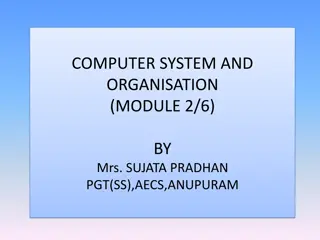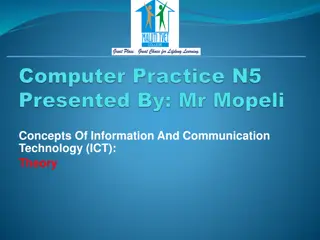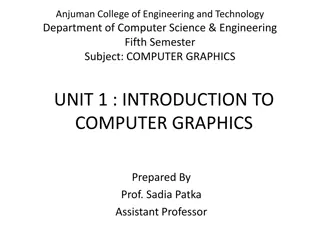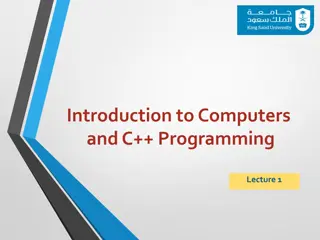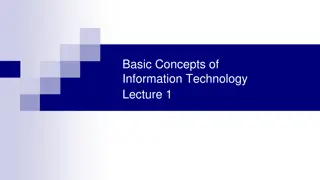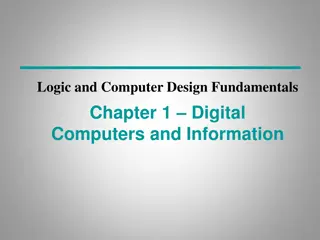Fundamentals of Computer Studies: Understanding the Evolution and Importance of Computers
Computer studies cover the history, aims, and objectives of computers, emphasizing their vital role in today's world. The course explores basic computer components, data processing, and the transformation of manual tasks to automated processes. Computers are indispensable tools for efficiency and precision in various fields, highlighting the necessity of computer knowledge in our increasingly digital society.
Download Presentation

Please find below an Image/Link to download the presentation.
The content on the website is provided AS IS for your information and personal use only. It may not be sold, licensed, or shared on other websites without obtaining consent from the author.If you encounter any issues during the download, it is possible that the publisher has removed the file from their server.
You are allowed to download the files provided on this website for personal or commercial use, subject to the condition that they are used lawfully. All files are the property of their respective owners.
The content on the website is provided AS IS for your information and personal use only. It may not be sold, licensed, or shared on other websites without obtaining consent from the author.
E N D
Presentation Transcript
Fundamentals of Computer Studies Lecture (1): History OF Computer AIMS AND OBJECTIVES OF THE COURSE To interact effectively with the computer. To know some basic things about the computer To know the uses of the basic components of the computer. To manage the system to some extent before involving an expert. To understand fundamentally the general scope of the computer system
INTRODUCTION Computer as a revolution left no area of life untouched in the present world. It is of tremendous help in all field of life. Hence, the knowledge of computer is a necessity for existence of everybody in this global village. The invention of computer has transformed our simple manual works to sophisticated life of automated works to meet the global demand for the higher productivity and increased efficiency with high precision. Computer is increasingly becoming compulsory in nearly all fields of studies, not because of anything but its accuracy and versatility in processing data. Many tasks at home or office are being automated rapidly with computer. Thus, it is becoming apparent that in whatever discipline or working sector, the computer is now a very vital tool for efficiency improvement and precision of job or task execution.
A computer is an electronic device, operating under the control of instructions stored in its own memory. These instructions tell the machine what to do. The computer is capable of accepting data (input), processing data arithmetically producing output from the processing, and storing the results for future use. Most computers that sit on a desktop are called Personal Computers (PCs). and logically,
The "computer" is an ensemble of different machines that you will be using to get your job done. A computer is primarily made of the Central Processing Unit (usually referred to as the computer), the monitor, the keyboard, and the mouse. Other pieces of hardware are commonly referred to as peripherals.
It is essential to know that information is as good as the data from which it is derived, and the transformation process which they are subjected to. Meaningless data or produces wrong information. Thus, computer gives you results corresponding to what data you supply and how you process it. inappropriate processing
1-1 USES OF COMPUTER People use computers in many ways; business, computers are used to track inventories with bar codes and scanners, check the credit status of customers, and transfer funds electronically, homes, tiny computers embedded in the electronic circuitry of most appliances control the indoor temperature, operate home security systems, tell the time, and turn video cassette recorders (VCRs) on and off. Automobiles regulate the flow of fuel, thereby increasing gas mileage, they also entertain, creating digitized sound on stereo systems or computer-animated features from a digitally encoded laser disc.
Computers are used extensively in scientific research to solve mathematical complicated data, or model systems that are too costly or impractical to build, such as testing the air flow around the next generation of aircraft. The military employs computers communications to encode messages, and to keep track of personnel and supplies. problems, investigate in and sophisticated unscramble
1-2 HISTORY OF COMPUTING Since the creation of man, a significant number of human activities has been ascribed to organizing and processing information so that it could be more easily presented for easy comprehension. Many devices have been used in the past before the advent of computer. It is then necessary to vividly look into their evolution
Early computing machines: Early computing machines: Abacus (-2500 BC): This is a hand- held device made of beads stung on rods in a frame. The rods correspond to positions of the digits while the beads correspond to the digits. Napier s Bone (2500BC): This was invented by John Napier s (1550 - 1617). This consists of small rods with appropriate markings on them. It is a mechanical aid to computation that consists of nine such rods (called bones) with one for each digit 1 through 9. He also invented logarithms which made possible to do division and multiplication by performing addition and subtraction. Slide Rule (1600AD) by William Oughtred (1575 - 660): He invented it in 1622 but announced it in 1632 this consist of rules on which markings represent logarithms of numbers and also permits calculation involving exponents, trigonometric functions, etc.
Pascal mechanical calculator (1600) or Numerical wheel calculator: - Blaise Pascal (1623 -1664) in 1642 invented the first adding machine called Pascaline. The brass rectangular box used eight moveable dials to add and sum up of eight figures long using base 10. It can perform all the four-arithmetic operation with previous unheard speed. Leibniz mechanical multiplier (1600): In 1694 Gottfried Wilhelm Von Leibniz (1646 -1716) improved upon the Pascaline by creating a machine that can also multiply using a system of dials and gear. Colmar s Calculator (1820) by Charles Xavier Thomas de Colmar: This presented a more practical approach to computing.
Punched-Card Joseph Marie Jacquard. Mechanical computer: Charles Gabbage (1792-1871). Father of the computer. Difference engine powered by steam and large as locomotive the machine has a stored program and could perform calculations and print the result automatically. We also have Analytical engine credited to him. machine loom) (1801): (Jacquard s
Hermann Hollerith (1860-1929) Hollerith s system punch-card reader machine: -for counting census result in 1890 in US. formed Tabulating Machine 1896(TMC) Automatic Tabulating Machine (ATM)-1900 TMC was renamed to International Business Machines Corporation (IBM) in 1924 after series of mergers. Company in
In summary, the history of computing began with an analog machine. In 1623 German scientist Wilhelm Schikard invented a machine that could add, and with the aid of logarithm tables, multiply and divide. Since then, the development has pass through a lot of stages such as the invention of punched cards to program patterns to create woven fabrics by Joseph-Marie Jacquard a French inventor in 19thcentury. Another early mechanical computer was the Difference Engine, designed in the early 1820s by British mathematician and scientist Charles Babbage. In the 1930s American mathematician Howard Aiken developed the Mark I calculating machine, which was built by IBM. This electronic calculating machine used components to replace mechanical components. relays and electromagnetic










